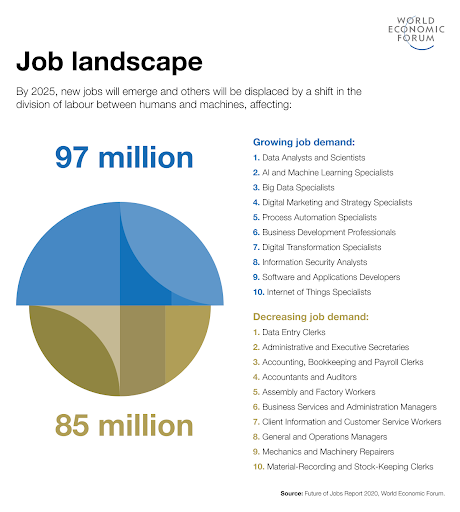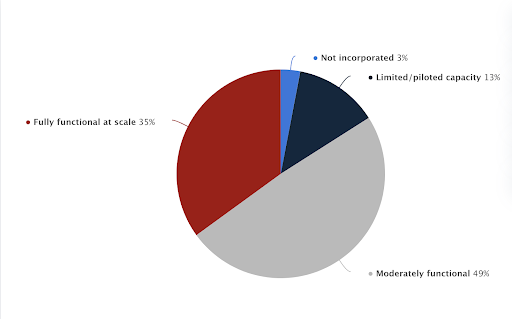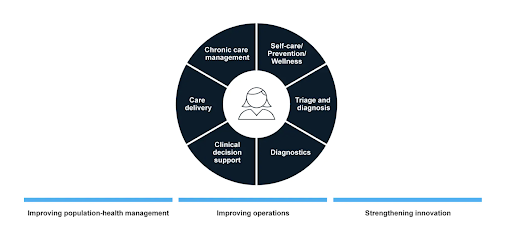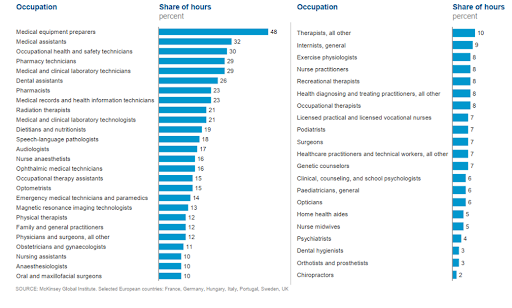Supervised by: Yash Salunkhe BSc (Hons). Yash is currently completing his MPhil in Economic Research at the University of Cambridge. He gained his BSc Econometrics and Mathematical Economics (EME) at the London School of Economics (LSE) in 2018. From 2018-19, Yash worked in Venture Capital in Pune, India, evaluating startups with a positive social impact. From 2019-2021, he worked in Wealth Management, helping large institutions invest their portfolios above $25 million. He has co-founded 2 charities: one focuses on improving outcomes in under-funded schools in India and the other was involved in varied community development projects.
Abstract
Artificial intelligence (AI) is rapidly being integrated into various industries and occupations, impacting how work is performed. This research paper will examine the ways in which AI is being implemented in different sectors and its effects on human workers. The finance, sports management, healthcare, and legal fields will be explored to understand how AI is changing job responsibilities, the labor market, and consumer services. While AI tools can improve efficiency, automate tasks and enhance decision making, there are also challenges regarding job displacement, bias, data privacy and ethics. Adaptation, reskilling and establishing governance frameworks will be key for professionals to maximize the benefits of AI while mitigating risks. The socioeconomic impact of AI shows potential savings, improved outcomes and quality of life gains, though equal access to these benefits remains a concern. Overall, AI is transforming how work is conceived and performed, altering the relationship between humans and technology in the modern workforce.
Introduction
AI has been the topic of discussion of this decade, with billions of people wondering what impact this technology is going to have in the world. As humans have evolved with technology, their relationship has been forever changing in every aspect, but one thing has remained constant. Amongst the rise in speculation and fear, technology has always been used to help us and make our work easier, but it has not replaced humans in any way.
As of right now, we are in the stage at which we don’t know if AI is going to replace us rather than help us but, as history tells us, that is most probably not going to be the case. AI is a magnificent tool, but there still needs to be humans supervising and analyzing what AI is actually doing. There needs to be human supervision behind this technology in order to ensure proper function, as well as human analysis on the information AI provides.
So, what are the actual predictions on the way AI is going to impact the labor market? According to the world economic forum, AI is expected to create a net amount of 12 million new jobs by 2025. More specifically, AI is expected to replace 85 million jobs while creating 97 million new jobs. In other words, AI is not set to replace us in any way, but rather revolutionize the dynamics of our work routine.

Technological progression is directly tied with the needs of the labor market. Evolution in these sectors implies that these needs are going to constantly be changing, meaning that some professions are going to become obsolete over time, but also that new professions are going to arise amid the developments in the technological context of the world.
In simpler words, as technology evolves, human jobs evolve at the same rate.
The Broad Spectrum of AI Implementation
This research paper will be focusing on the disparate methodologies in which AI is being implemented. It is important to understand what the current relationship with AI is in different work sectors and how they affect the role of human workers.
The term AI involves a lot of sectors in many different ways. It would be unwise to generalize the impact of AI, since it has a variety of uses in many fields. For this reason, there are 4 important sectors that are going to be covered in this research paper: Finance & Investment Management, Sports Management, Healthcare, and Law. The paper will focus on the way AI is going to impact both the labor force and the consumers of said services. Trying to understand the way in which AI will change the dynamics of these sectors is crucial to understand how we will interact with them.
Finance and Investment Management
The use of AI has been gaining popularity in the financial sector due to its malleability and the way that it can be adapted for consumer use, as well as facilitating the work of professionals in the field.
One of the most important aspects of AI is automation, the ability for said intelligence to operate without constant human supervision. Automation can help financial experts to minimize time wastage on tasks that previously could only be carried out by humans, thus providing a better work experience for experts while at the same time improving customers’ experience. Another fundamental aspect of this conundrum is evaluating the complexity of said tasks, and how this can be beneficial for the consumer and experts, but also how it can compromise other people’s vocation.
Customer Service
Customer service is one of the aspects that AI has been taking over recently. Banks have been using chatbots to manage more clients efficiently. Chatbots are able to autonomously answer customers’ doubts, allowing for a quick and effective way of communication. One of the most prominent examples in the industry is the Bank of America chatbot “Erica”, which has helped over 32 million customers with their everyday financial needs since its launch in 2018. According to Bank of America, 98% of clients are able to get appropriate answers for Erica. The bot also has the ability to redirect people to financial experts for more complex doubts.
AI has also allowed for more customisation and personalisation. According to Forbes, AI can provide customers with customized financial advice, targeted product recommendations, and prevent people from falling for scams. By allowing AI to analyze a consumer’s patterns and behaviors, banks are able to reach customers in new ways that were previously not possible.
As is clearly evident, the Bank of America has been able to cut the middle man, which in this case is a phone call operator. This makes the process of contacting the bank more direct and efficient. And while over $3 billion USD have been invested to implement this technology, banks could potentially save money by laying off workers that previously held these positions. This phenomenon is known as “structural unemployment”, and it is the process in which people lose their job since their contributions become obsolete due to technological advancement. Society becomes more unequal as technology advances, since skilled labor is valued over less skilled labor, which is the concept behind the capital skill complementary.
Risk Management
Financial experts have also adapted AI to be a valuable and practical risk management tool. In this case AI can use pattern recognition in order to detect and predict risky investments for a company. Data analysis is highly priced in the industry since it requires a great deal of human skill and labor. AI is going to reduce the cost of data analysis, allowing experts to make more informed decisions.
One way in which AI is used to reduce risk is by using pattern-detecting to forecast the growth of a certain investment. This allows professionals to forecast growth, plot trend lines, and to evaluate the risk that comes with a certain investment. This allows analysts to make better informed investments by being able to predict potential upsides or downsides. Since these predictions are based on large amounts of data that were previously only analyzed by humans on a smaller scale, this technology opens up new possibilities when it comes to data analysis.
In another matter, AI can be used to prevent fraud and loan out money to people that are most likely to pay said loans back. AI analyzes a consumer’s spending patterns and determines whether a person is eligible to get a loan, or if their spending patterns reveal a risk towards banks that is worth considering. This way, credit score analysis can become easier and more effective for professionals.
Trade Bots
Lastly, I want to talk about trade bots and the impact that they can have on the financial sector. As the name suggests, trade bots are able to manage assets on financial markets. Trade bots are able to analyze patterns in order to make informed decisions on when to buy and sell an asset.
There are various tradeoffs to this type of technology. On the positive side, trade bots are active throughout the whole market window, meaning that they do not have to rest, unlike their human counterparts. One key advantage of trade bots is that they are easily customisable, meaning that a user can set the amount of risk, their own “stop-loss” percentage, what industries to invest in, etc. Trade bots are able to continuously carry strategies that have already worked in the past. One of the most imposing challenges for human traders is to maintain discipline and peace of mind during economically uncertain times; trading bots are able to easily perform these tasks because they have no feelings. Lastly, trading bots allow for users to easily diversify their portfolio by analyzing various stocks in an efficient amount of time.
Still, there are some downsides to trade bots. The market is always changing, so what worked in the past may not always work in the future. For this reason, trade bots may imply trading strategies that were successful in the past, but may be unfit for current times. Trade bots also require vast amounts of monitoring. Checking that the bot is connected and doesn’t fail, power losses or computer fails, or simply that the bot is not failing and conducting bad trades.
Trade bots don’t have the knowledge to access news and to be constantly informed on how the market changes. They also don’t have the knowledge of advanced traders, they only see everything through numbers. For this reason, trade bots can be a tool for people to get an idea of how the market works, they may even be useful to pick certain assets. But at the end, people should hesitate to fully automate their personal investments, and human traders are still more knowledgeable in this topic.
Finance Conclusion

As the graph shows, many firms involved in the financial sectors have started to implement AI to some degree. As shown by the graph, a majority of firms have implemented AI to a moderate level, meaning that AI has a role in the company, but humans still prevail in their workforce. This shows the current state of AI in finance, which is using it as a tool to enhance human labor, not replace it.
Sports Management
In recent years, advancements in artificial intelligence have significantly impacted various industries and revolutionized the way and effectiveness of handling complex tasks.
The sports management sector is one of many industries that have been impacted by advances in artificial intelligence. Some of the key aspects of the sports management sector are the administration and organization of sports events, but the epicenter of action of AI in the sports management sector is surrounding a teams performance through player analysis. It is one of the greatest challenges that sports teams face as it requires significant time and thought input. AI creates a seemingly perfect solution to time conservation and the effectiveness of managing sports teams. Systems that are powered by AI can analyze data like speed, agility, and heart rate from sensors, wearables, and cameras. This allows coaches to improve their decision-making, as they have more pre-analyzed data that might offer insight into each player’s ability.
Another key area in sports management where AI has made significant strides is in injury prevention. AI is able to analyze player data and previous injury records to identify risk factors which in turn can be taken into consideration when trying to prevent any injuries. AI is also able to aid in the rehabilitation process in the case that a player gets injured. It does this by developing customized recovery plans that are based on personal needs and genetic factors to guarantee a risk free and quick recovery. Some people might doubt the safety or reliance of health advice by a non-human machine which is understandable since health is our most valuable good. However, people should know that AI does not make up any information, but rather it browses and analyzes secondary data to make a correct and most suited advice.
Furthermore, AI is able to develop strategies for certain sports such as football. It takes every player’s strengths and weaknesses into consideration to create a synergistic effect between the players in certain maneuvers. It is able to analyze previously used strategies and maneuvers to calculate how effective each strategy was and what it lacked in. It is possible that many sports teams will be reluctant to the idea that some machine tells them what to do even though they have a coach with decades of experience. I believe that in this specific niche in sports management, AI first has to prove itself in all other aspects regarding sports in order for players or sports teams to implement it.
Another way in which AI is able to support the management of a sports team is through scouting and recruiting. This links to my previous paragraph where AI analyzes each players ability after which it offers suggestions. Here, AI analyzes a wide range of players by other teams and specifically searches for players with skills that the current team is lacking. E.g. A sports team is lacking a good defender. AI will then scout all other teams for players which are good defenders that suit the team well. Ai also does a risk and reward analysis when trying to decide if a new player should join the team. This allows the manager of a sports team to thoroughly calculate how much a player would earn the team, and how much he would cost the team.
Lastly, AI can play a vital role in enhancing fan engagement and the overall fan experience for sports teams. With the help of AI-powered chatbots and virtual assistants, teams can provide personalized and interactive experiences for their fans. These AI systems can engage with fans through various channels, including websites, mobile apps, and social media platforms, answering their queries, providing real-time updates, and delivering tailored content based on individual preferences. AI can analyze vast amounts of fan data, including social media interactions, ticket purchases, and viewing habits, to understand fan sentiment and preferences. This enables teams to create targeted marketing campaigns, offer personalized recommendations, and provide customized offers and promotions to enhance fan loyalty. Furthermore, AI-powered systems can generate automated highlights and personalized content based on fan interests, delivering immersive and engaging experiences. By leveraging AI for fan engagement, sports teams can build strong connections with their fan base, increase fan satisfaction, and cultivate a vibrant and supportive community around their brand.
Healthcare
In the latest years AI has made significant progress in the healthcare sector, having the potential of reshaping medicine by making it more effective and accessible. The latest developments based on AI technology are focused on medical imaging and diagnostics, personalized treatment and care, virtual assistants and chatbots.
Innovative researchers are utilizing potent AI capabilities to study large volumes of data and unearth novel patterns for developing pioneering treatments, therapies, and medicines.
By harnessing machine learning algorithms’ power for analyzing immense datasets effortlessly identifies significant discoveries that might have gone unnoticed. One such breakthrough was made by MIT scientists through a machine learning process detecting Halicin –a revolutionary antibiotic- effective against drug-resistant bacterias (Trafton, 2020).
In addition, data collected by monitoring devices feed into AI technologies providing instant alerts and alarms when patients suffer adverse health outcomes—a swift intervention that saves lives daily globally.
Our objective in this article is to examine the implications of integrating AI into global healthcare systems and its specific effect on Europe.
Customer Service
EIT Health (a subsidiary of European Institute of Innovation and Technology) and MCG (McKinsey Center for Government) carried out a study to investigate the impact of automation and AI on specific skills related to healthcare activities. Their analysis focused on three domains where AI could bring advancements: population health management improvement, operational streamlining, and innovation strengthening (Garcia, 2020). Results highlighted both challenges as well as possibilities for further development.
In light of forecasts from The World Health Organization (WHO), it appears likely that we will face significant deficits within our global healthcare staffing levels over coming years – with estimates pointing towards a possible deficit of almost 10 million doctors and nurses worldwide towards the year 2030. A similar scenario presents itself within Europe too; projections suggest that there will be substantial requirements for healthcare workers totaling as much as 18.2 million whilst there are currently only around 8.6 million available medical professionals ready to meet this need.
Automation may appear like it would take jobs away from crucial staff caring for patients- but instead we find it serves as remedies for seemingly never-ending administrative tasks weighing down available professionals in under-staffed institutions.
Providing safe and quality patient care requires nursing personnel to take on multiple roles simultaneously – from preparing medications to managing ward coordination activities while maintaining clear communication channels with colleagues across the organization. As a result of these responsibilities taking up considerable amounts of their workday hours, studies have shown that nurses dedicate less than 40% of their working time actively attending to patients directly. On the brighter side though – technology advancements hold immense potential in coping with heavy administrative burdens through automation and Artificial Intelligence (AI). Implementation would create leaner streamlined processes allowing more time for nurses’ critical engagement in personalizing patient-led approaches while displaying heightened sensitivity towards families’/caregivers’ needs.
AI’s integration with laboratory applications is opening new avenues to reshape healthcare operations’ landscape by increasing efficiency while optimizing resource usage. The use of AI-powered software systems provides significant technological advantages such as automating mundane tasks like diagnosis or administrative processes involved in patient care management resulting in quality time allocated towards critical patient-centered services. Most importantly, Digital transformation also increases opportunities to reassess workforce needs addressing quality-driven results thus promoting effective resource allocation and ultimately building better organizational structures.
With wearable technology now boosting artificial intelligence (AI) abilities – there’s room for achieving substantial socioeconomic gains across numerous fields such as medicine. Devices including smartwatches and biosensors monitor health data from patients continually, making way for real-time recommendations by leveraging AI algorithms that aid medical staff as well as individuals themselves – leading to higher productivity levels of staff and lower frequency of visits by patients alongside significant cost savings via technological preventative measures. Wearable tech has already delivered positive changes in cardiovascular disease diagnosis, diabetes treatment, remote patient monitoring along with postoperative recovery tracking. Research carried out (Biundo, 2020) demonstrated that the use of AI technology may result in substantial savings for European medical organizations. Specifically, it was shown that up to 53 million hours could be saved annually on routine analysis tasks, leading to a possible cost reduction of €883 million.
The integration of advanced AI technology within healthcare services shows great promise towards providing better outcomes while reducing delivery costs for private practices as well the public welfare system. For instance, medical imaging has been found to improve diagnostic accuracy significantly thus preventing pulmonary illnesses from taking hold and resulting in over 1900 lives saved every year throughout Europe alone.
Personal wellness app is another example of AI utilization in healthcare, offering dietary plans custom-made for particular people based on their needs which have the power to prevent around 7000 deaths annually through promoting weight loss measures. Furthermore, these apps also act as behavioral coaches and monitor live what happens with a patient’s health.
The healthcare industry is witnessing significant changes with the introduction of artificial intelligence: the utilization of AI in various medical fields has shown great potential in reducing costs and improving patient outcomes. It is also expected that a series of new roles will emerge at the intersection of medicine and data science to ensure the implementation of AI products in healthcare. Therefore, this technological advancement holds a high socio-economic impact.
Law
The legal industry has experienced a significant transformation due to the rapid advancements in Artificial Intelligence (AI). AI technologies have introduced innovative opportunities and challenges, revolutionizing the practice of law. This essay delves into the profound impact of AI in the legal domain, focusing on its potential to enhance efficiency, facilitate informed decision-making, streamline research processes, and automate routine tasks. However, ethical concerns, bias, privacy, and the potential displacement of jobs also accompany the integration of AI in the legal profession.
AI’s integration in law has yielded considerable improvements in efficiency and automation of legal procedures. Utilizing AI-powered tools, vast amounts of legal data can be analyzed, extracting relevant information and expediting tasks such as document review, contract analysis, and due diligence. This automation minimizes the time and resources required, enabling legal professionals to concentrate on more complex and strategic assignments.
The utilization of AI technologies has the potential to enhance decision-making in the legal realm. Machine learning algorithms can analyze previous cases, legal precedents, and legislation, offering valuable insights and predictions. Judges and lawyers can leverage this information to make more informed decisions and develop robust legal strategies. Furthermore, AI-powered tools excel at detecting patterns and anomalies within extensive datasets, aiding in risk assessment and litigation strategies. By providing objective and data-driven analysis, AI contributes to a fairer and more consistent legal system.
AI-powered research tools have revolutionized the process of legal research. Rather than manually sifting through voluminous case law and legal texts, legal professionals can now employ AI algorithms to swiftly locate pertinent information and precedents. Natural Language Processing (NLP) enables advanced search capabilities, semantic analysis, and contextual comprehension. These tools not only save time but also ensure comprehensive research, reducing the risk of overlooking critical information. The ability of AI to process and interpret copious amounts of data empowers lawyers to provide more accurate advice to their clients.
While AI presents significant benefits, it also raises ethical concerns. The potential for bias within AI algorithms has garnered substantial attention. If not meticulously designed and trained, AI systems can amplify existing biases present in legal data, leading to unjust outcomes. Ensuring fairness and accountability in AI algorithms is crucial to maintain trust in the legal system. Establishing transparency in the development and deployment of AI technologies, implementing robust data governance practices, and conducting continuous monitoring and auditing are essential to address these concerns.
The integration of AI in law introduces challenges regarding privacy and security. Legal professionals frequently handle sensitive and confidential information. Safeguarding client data from unauthorized access, ensuring secure data storage, and maintaining client confidentiality become paramount. AI technologies should adhere to rigorous data protection regulations and incorporate robust encryption and cybersecurity measures. The establishment of ethical frameworks and guidelines to govern the use of AI in handling sensitive legal information is imperative.
The increased implementation of AI in law has raised concerns regarding job displacement among legal professionals. As AI automates routine tasks, certain roles may become obsolete or experience a significant decline in demand. Nevertheless, AI also offers opportunities for legal professionals to adapt and focus on tasks that require human judgment, creativity, and empathy. Developing interdisciplinary skills, such as understanding AI technologies, data analysis, and legal ethics, will be crucial for lawyers to thrive in an AI-driven legal landscape.
Artificial Intelligence has brought about transformative changes in the legal sector, enhancing efficiency, facilitating informed decision-making, streamlining research processes, and automating routine tasks. However, addressing ethical concerns, mitigating bias, prioritizing privacy, and adapting to the changing job landscape are critical aspects of responsibly harnessing the power of AI in the legal profession.
Conclusion
As discussed throughout the whole paper, AI is going to bring new ways for people to interact with different sectors of the economy. By automating processes that were previously done by humans, experts are able to save time and use their knowledge in more crucial tasks. AI is set to boost productivity of economies by maximizing efficiency.
But if this process is being automated, aren’t people losing jobs? Yes, some people are going to lose their job to this process, but as history has shown us, new jobs are going to emerge in the process. So what is happening here isn’t that human input is becoming less valuable and less desired, the human input is simply evolving. Our necessities are constantly evolving, including the necessities of the labor market for human labor.
In conclusion, AI is going to optimize the way humans work, changing the dynamics of human labor to understand and implement AI.

“Transforming healthcare with AI: The impact on the workforce and organizations” https://www.mckinsey.com/industries/healthcare/our-insights/transforming-healthcare-with-ai
As per Biundo’s study on AI in healthcare, it can have a significant impact on the sociological and economic aspects of the field. By analyzing key indicators such as life save estimation, cost reduction, and time saved, we can understand its influence better. The implementation of AI has the potential to save up to 400,000 lives per year and free up 1.8 billion hours for nurses and doctors. In total, up to 200 billion euros can be saved in Europe (Biundo, 2020).
Automation typically targets particular job-related activities, resulting in more time available for other tasks. Up to 15% of current healthcare work could be automated by 2030, according to the EIT.

“Transforming healthcare with AI: The impact on the workforce and organizations” https://www.mckinsey.com/industries/healthcare/our-insights/transforming-healthcare-with-ai
Works Cited
- Trafton, A., 2020, Artificial intelligence yields new antibiotic, A deep-learning model identifies a powerful new drug that can kill many species of antibiotic-resistant bacteria, MIT News Office, https://news.mit.edu/2020/artificial-intelligence-identifies-new-antibiotic-0220
- García, J., et al (2020), Transforming healthcare with AI: The impact on the workforce and organizations, EIT Health https://www.mckinsey.com/industries/healthcare/our-insights/transforming-healthcare-with-ai#/
- Biundo, E., Pease, A., et al (2020), The socio-economic impact of AI in healthcare, MedTech Europe Socio-economic impact of AI on European health systems (deloitte.com)
- Shaheen, M., (2021), AI in Healthcare: medical and socio-economic benefits and challenges, ScienceOpen Preprints AI in Healthcare: medical and socio-economic benefits and challenges – ScienceOpen
- Kumar, P., Chauhan, S., Awasthi, L., (2022), Artificial Intelligence in Healthcare: Review, Ethics, Trust Challenges & Future Research Directions, ScienceDirect Artificial Intelligence in Healthcare: Review, Ethics, Trust Challenges & Future Research Directions – ScienceDirect
- Lee, D., Yoon, S., (2021), Application of Artificial Intelligence-Based Technologies in the Healthcare Industry: Opportunities and Challenges, Digital Healthcare Innovation IJERPH | Free Full-Text | Application of Artificial Intelligence-Based Technologies in the Healthcare Industry: Opportunities and Challenges (mdpi.com)
- Susskind, R., & Susskind, D. (2019). The Future of the Professions: How Technology Will Transform the Work of Human Experts. Oxford University Press. https://www.amphilsoc.org/sites/default/files/2018-11/attachments/Susskind%20and%20Susskind.pdf
- University of San Diego (2023) Artificial Intelligence in Finance [15 Examples]. USD. https://docs.google.com/document/d/1XblgQJJkCzaqBfrsBip1MHPbjaF_t42xt_1ZCg1V08U/edit
- Aldrige, A (October 12, 2022) Bank of America’s Erica Tops 1 Billion Client Interactions, Now Nearly 1.5 Million Per Day. Bank of America. https://newsroom.bankofamerica.com/content/newsroom/press-releases/2022/10/bank-of-america-s-erica-tops-1-billion-client-interactions–now-.html
- Folger, J. (March 4 , 2021) Automated Trading Systems: The Pros and Cons. Investopedia. https://docs.google.com/document/d/1XblgQJJkCzaqBfrsBip1MHPbjaF_t42xt_1ZCg1V08U/edit




